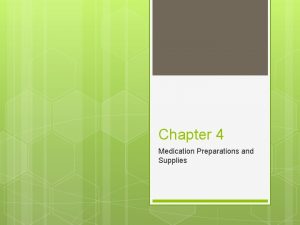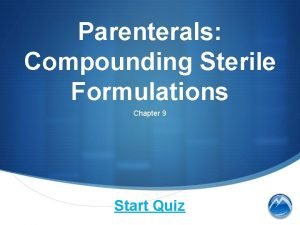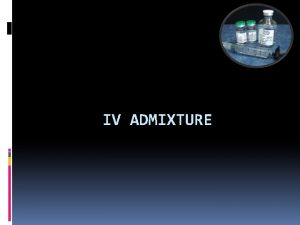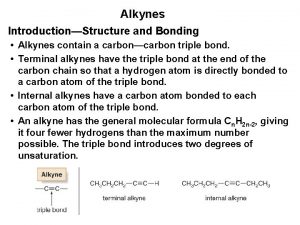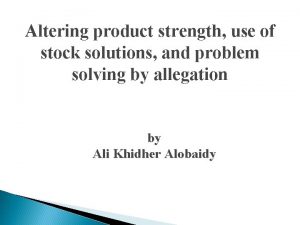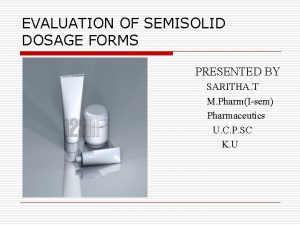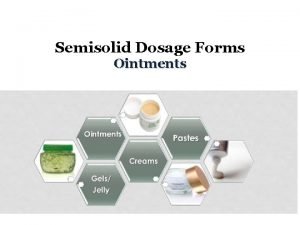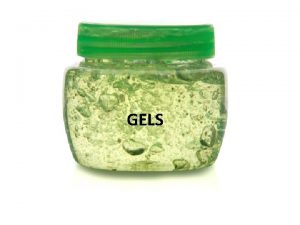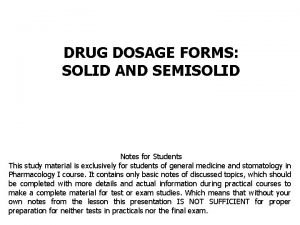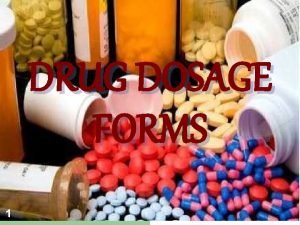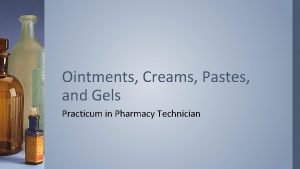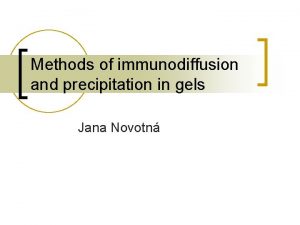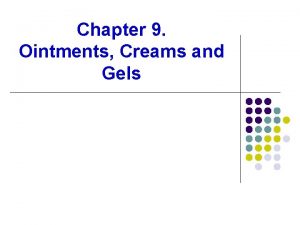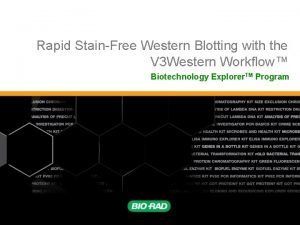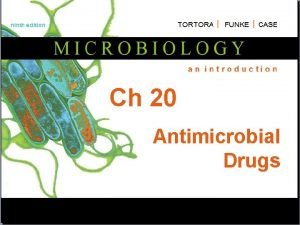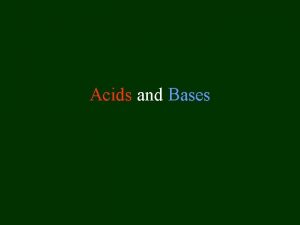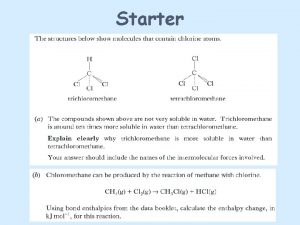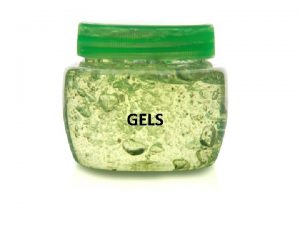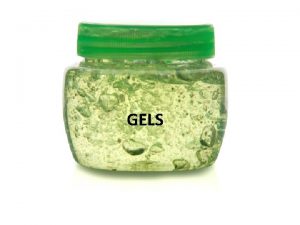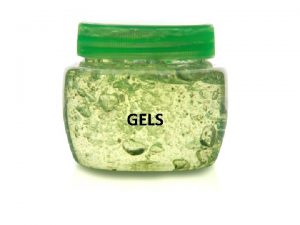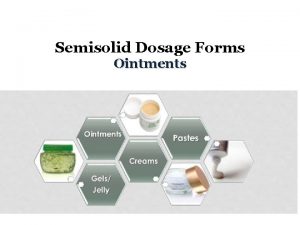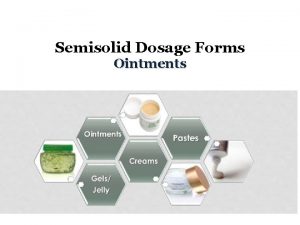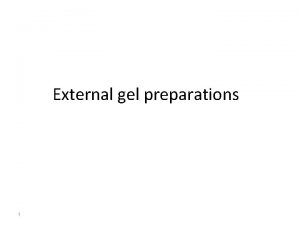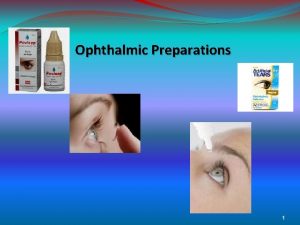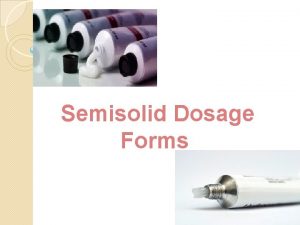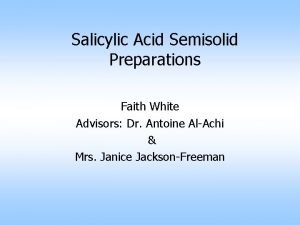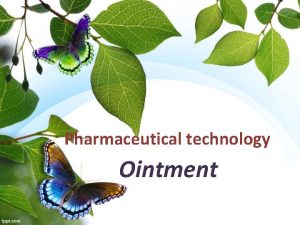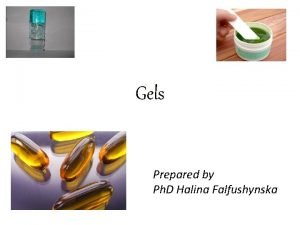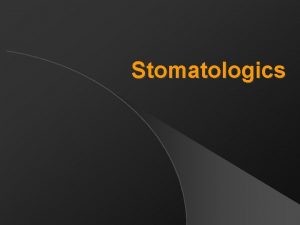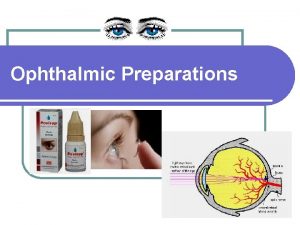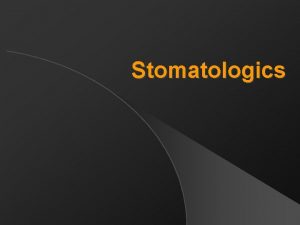GELS Gels Gels are semisolid preparations that contain









































- Slides: 41

GELS

Gels • Gels are semisolid preparations that contain small inorganic particles or large organic molecules interpenetrated by a liquid. • The vehicle may be: Aqueous , hydroalcoholic , alcohol based or non aqueous • In a typical polar gel, a natural or synthetic polymer builds a three-dimensional matrix throughout a hydrophilic liquid. • Gels are attractive delivery systems as they are simple to manufacture and suitable for administering drugs through skin, oral, buccal, ophthalmic, nasal, otic, and vaginal routes • Gels may appear transparent or turbid based on the type of gelling agent used

Gels Gelling Agent : These are substances which, when added to an aqueous mixture, increase its viscosity without substantially modifying its other properties, such as taste • Types of Gelling Agents: 1. Natural Polymers e. g. proteins, polysaccharides , natural gums, such as tragacanth, carrageenan, pectin, agar and alginic acid 2. Semi synthetic Polymers e. g. , cellulose derivatives methylcellulose, hydroxypropylmethylcellulose and carboxymethylcellulose 3. Synthetic polymers such as carbomer 934

• Carbomers are high-molecular-weight water-soluble polymers of acrylic acid cross-linked with allyl ethers of sucrose and/or pentaerythritol. • Their viscosity depends on their polymeric composition. • The NF contains monographs for six such polymers, carbomers 910, 934 P, 940, 941, and 1342. • They are used as gelling agents at concentrations of 0. 5% to 2. 0% in water.

Properties of Gels 1. Ideally, the gelling agent must be inert, safe and cannot react with other formulation constituents. 2. The gelling agent should produce a sensible solid-like nature at the time of storage which is easily broken when exposed to shear forces produced by squeezing the tube, trembling the bottle or at the time of topical application. 3. It should have suitable anti-microbial agent. 4. The topical gel must not be sticky. 5. The ophthalmic gel must be sterile. 6. The apparent viscosity or gel strength increases with an increase in the effective crosslink density of the gel. However, a rise in temperature may increase or decrease the apparent viscosity, depending on the molecular interactions between the polymer and solvent.

Classification of Gels can be classified based on nature of continuous phase 1. Hydrogels (Water based) 2. Organogels (With a non-aqueous solvent) 3. Xerogels

Hydrogels (Water based) • A hydrogel is a network of polymer chains that are hydrophilic in which water is dispersion medium. • They are highly absorbent natural or synthetic polymeric networks. They also have a degree of flexibility, due to their significant water content These gels exhibit unique physicochemical properties, including: 1. The ability to absorb a considerable mass of aqueous fluid (often 100 times the original mass) whilst still retaining a three-dimensional structure. 2. Hydrogels exhibit robust mechanical properties, being resistant to fracture following exposure to stresses frequently up to 1 k. Pa 3. Hydrogels exhibit excellent flexibility.

• Uses for hydrogels 1. Sustained-release drug delivery systems 2. Rectal drug delivery and diagnosis 3. Hydrogel-coated wells have been used for cell culture 4. As scaffolds in tissue engineering 5. As environment sensitivity detector 6. Contact lenses (silicone hydrogels, polyacrylamides, polymacon) 7. ECG medical electrode 8. Dressing of healing

Hydrogel wound dressings • Hydrogels wound dressings differ from other dressings as they have the ability to add moisture to dry wounds. • Thus, they are used to facilitate autolytic debridment (the release of a protein-rich exudate containing phagocytes and other materials from the blood capillaries onto the wound surface engulfs the debris of dead cells and bacteria ) , and they maintain a moist healing environment on clean granulating wounds. • Hydrogel dressings are composed of three-dimensional swollen networks of hydrophilic polymers which contain a large proportion of water within their structure.

• Hydrogels can be applied to a wound in two forms that have different features and uses with respect to wound care : 1. An amorphous gel that can take up the shape of the wound (filler) 2. An elastic sheet or film

Amorphous gel wound (filler) • These contain 70– 95% water and are produced by dispersing natural (e. g. the alginates or carboxymethylcellulose) or synthetic (e. g. polyvinyl pyrrolidone, polyacrylamide) hydrophilic polymers in water. • The rheological properties of the gels vary markedly in different commercial products according to the specific polymers used and their concentrations in the dressing. • These differences influence clinical use and handling characteristics. • For example, the apparent viscosity of an amorphous gel will influence its ability to fill all or part of the wound cavity, and subsequently to remain on the wound bed. Subsequent packaging, e. g. whether the dressing is enclosed in tubes, spray bottles or foil packs, will depend on how the dressings behave rheologically under shear.

Amorphous gels progressively lose structure on dilution with exudate until the polymer is dispersed. Thus, when the gel is applied directly to the wound, it is usually covered with a secondary dressing, such as a foam or gauze. Any exudate is absorbed into the gel whilst moisture evaporates through the secondary dressing. Saturated gauzes, obtained when gauze is impregnated with amorphous hydrogel, are sometimes used to fill deeper wounds.

Elastic sheet or film The polymer forms a cross-linked structure (anywhere from 6%-30%) that physically entraps water to form a solid sheet that can be cut to the wound. Despite their high water content, some hydrogels can also swell further to absorb slight-to-moderate amounts of exudate. • Hydrogel sheets do not require a secondary dressing because they are manufactured with a semipermeable polymer backing, which may or may not have adhesive borders, that controls the amount of water vapour transmitted through the dressing.

• Hydrogel dressings are suitable for use at all stages of wound healing, with the exception of infected or heavily exuding wounds. They cannot absorb much exudate and an unpleasant smell may arise due to skin maceration and bacterial proliferation in infected wounds – encouraged by the large water content of the gel. • Although these dressings need to be changed frequently, they do not disturb fragile tissue and are suitable for burns and other painful wounds. Amorphous gels and impregnated gauzes are used as primary dressings, whereas hydrogel sheets may be used as primary or secondary dressings.

Organogel • An organogel is a non-crystalline, non-glassy thermoreversible solid material composed of a liquid organic phase trapped in a 3 D cross-linked network. • The liquid can be, E. g. , vegetable oil, an organic solvent or mineral oil. Xerogels • It is a solid formed from a gel by drying with unrestricted shrinkage. It is frequently retains high porosity (15 -50%) and huge surface area (150 -900 m 2/g) • E. g. , Tragacanth ribbons, β-cyclodextrin, dry cellulose and polystyrene, gelatin sheets and acacia tears.

Classification of Gels Type I gels Types Of gels on the basis of nature of bond involved in 3 dimensional solid network. Hydrophilic polymers gels (single phase gels) Type II gels Dispersed solids gels (Two phase gels)

GELS • Single-phase gels are gels in which the macromolecules are uniformly distributed throughout a liquid with no apparent boundaries between the dispersed macromolecules and the liquid. • A gel mass consisting of floccules of small distinct particles is termed a two-phase system, often referred to as a magma.

Dispersed Solids Gels ( Two phase gels) • A gel mass consisting of floccules of small distinct particles is termed a two-phase system or dispersed solids gels. • The nature of interaction between particles in network may be: 1. Van der waals , e. g. Al-hydroxide gel USP 2. Electrostatics interaction, examples include kaolin, bentonite and aluminium magnesium silicate

• The bond strength between the particles is weak • Interparticle bonds are broken by the application of relatively low shearing stresses (such as those that occur whenever the product is shaken), thereby liberating the individual particles. • Following removal of the stress the bonds between the particles will reform and hence the rheological structure of these systems is recovered, this is termed thixotropy.

• If the particle size of the dispersed phase is relatively large, the gel mass is sometimes called as a magma. • Milk of magnesia (or magnesia magma), which consists of a gelatinous precipitate of magnesium hydroxide, is such a system.

Formulation considerations for pharmaceutical gels • There are several formulation considerations open to the pharmaceutical scientist concerning the formulation of pharmaceutical gels. These include: (1) The choice of vehicle (2)The inclusion of buffers (3)Preservatives (4) Antioxidants (5) Flavors/sweetening agents; and (6) Colors

Manufacture of Gels • Generally the water soluble excipients are firstly dissolved in vehicle, in a mixing vessel by using mechanical stirrer. • To prevent aggregation, add hydrophilic polymer to the stirred mixture slowly. • Stirring is continued until the dissolution of the polymer has occurred. • The excessive stirring results in entrapment of air. The mixing rate must not be extreme or a mixing vessel may be used to which a vacuum may be pulled, to prevent the entrapment of air.

CREAMS

creams • Pharmaceutical creams are semisolid preparations containing one or more medicinal agents dissolved or dispersed in either a W/O emulsion or an O/W emulsion or in another type of water-washable base. • Creams are more fluid compared to other semisolid dosage forms, such as ointments and pastes, since the bases used in creams are generally o/w emulsions. • Creams have a whitish with creamy appearance. • The use of creams as drug delivery systems is associated with good patient acceptance

Uses • Act as a barrier to protect the skin Could be a physical barrier or a chemical barrier • Aid in water retention of moisture • Cleansing and emollient • Act as vehicle for drug substances

Medicated creams

• Oil-in-water emulsions are most useful as water washable bases, whereas water-in-oil emulsions are emollient and cleansing. w/o cream o/w cream Contain lipophyllic emulsifying agent Contains o/w emulsifying agent Use as emollient or as cleansing agent o/w creams are elegant in appearance and more accepted cosmetically

Cold cream A semisolid white w/o emulsion prepared with cetyl ester wax, white wax, mineral oil, sodium borate, and purified water. • Sodium borate combines with free fatty acids present in the waxes to form sodium salts of fatty acids (soaps) that act as emulsifiers. • These are produced by emulsifying agents of natural origin, e. g. beeswax, wool alcohols or wool fat. • They are useful as softening and cleansing agents ex. a cold cream is used to remove makeup. • The name, cold cream, refers to the cooling sensation associated with the slow evaporation of the dispersed aqueous phase. • Other common cold cream components include mineral oil, jojoba oil, lanolin, glycerin, alcohol, borax, and beeswax in addition to preservatives such as methylparaben and propylparaben. .

creams • Creams find primary application in topical skin products and in products used rectally and vaginally. • Patients often prefer a w/o cream to an ointment because the cream spreads more readily, is less greasy, and the evaporating water soothes the inflamed tissue. • Pharmaceutical manufacturers frequently manufacture topical preparations of a drug in both cream and ointment bases to satisfy the preference of the patient and physician.

Vanishing cream • an o/w emulsion that contains a large percentage of water as well as a humectant (e. g. , sorbitol, glycerin, or propylene glycol) that retards surface evaporation of water. • These are produced by synthetic waxes, e. g. macrogol and cetomacrogol • They are useful as water-washable bases • Examples : Shaving creams , Hand creams , Foundation creams • Upon rubbing this cream on the skin, the external/continuous aqueous phase evaporates, leading to increased concentration of a water-soluble drug in the oily film that adheres to the skin. This increase in the concentration gradient of the drug across the stratum corneum promotes percutaneous absorption

creams • An o/w cream is non-occlusive because it does not deposit a continuous film of waterimpervious liquid. • However, such a cream can deposit lipids and other moisturizers on and into the stratum corneum and so restore the tissue's hydration ability, i. e. the preparation has emollient properties.

Manufacturing process • Preparation usually involves separating the formula components into two portions: lipid and aqueous. • The lipid portion contains all water-insoluble components and the aqueous portion the water-soluble components. • Both phases are heated to a temperature above the melting point of the highest melting component. • The phases then are mixed, and the mixture is stirred until reaching ambient temperature or the mixture has congealed. Mixing • generally is continued during the cooling process to promote uniformity.

• High-shear homogenization may be employed to reduce particle or droplet size and improve the physical stability of the resultant dosage form. • The active pharmaceutical ingredients (APIs) can be added to the phase in which it is soluble at the beginning of the process, or • it can be added after the cream is prepared by a suitable dispersion process such as levigation or milling with a roller mill. • Creams usually require the addition of a preservative(s) unless they are compounded immediately prior to use and intended to be consumed in a relatively short period of time.

Pastes

• Pastes are ointments containing as much as 50% powder dispersed in a fatty base and therefore are stiffer. • They are less greasy than ointments because the powder absorbs some of the fluid hydrocarbons. • Pastes lay down a thick, unbroken, relatively impermeable film.

Pastes • Pastes can be prepared in the same manner as ointments, by direct mixing or the use of heat to soften the base prior to incorporating the solids, which have been comminuted and sieved. • when a levigating agent is to be used to render the powdered component smooth, a portion of the base is often used rather than a liquid, which would soften the paste.

Pastes • Because of the stiffness of pastes, they remain in place after application and are effectively employed to absorb serous secretions. • Because of their stiffness and impenetrability, pastes are not suited for application to hairy parts of the body.

MISCELLANEOUS SEMISOLID PREPARATIONS • PLASTERS • Plasters are solid or semisolid adhesive masses spread on a backing of paper, fabric, or plastic. • The adhesive material is a rubber base or a synthetic resin. • Plasters are applied to the skin to provide prolonged contact at the site. • Unmedicated plasters provide protection or mechanical support at the site of application.

PLASTERS • Medicated plasters provide effects at the site of application. • They may be cut to size to conform to the surface to be covered. • Among the few plasters in use today is salicylic acid plaster used on the toes for the removal of corns. • The horny layers of skin are removed by the keratolytic action of salicylic acid. • The concentration of salicylic acid used in commercial corn plasters ranges from 10% to 40%.

GLYCEROGELATINS • Glycerogelatins are plastic masses containing gelatin (15%), glycerin (40%), water (35%), and an added medicinal substance (10%), such as zinc oxide. • They are prepared by first softening the gelatin in the water for about 10 minutes, heating on a steam bath until the gelatin is dissolved, adding the medicinal substance mixed with the glycerin, and allowing the mixture to cool with stirring until congealed.

GLYCEROGELATINS • Glycerogelatins are applied to the skin for the long term. • They are melted before application, cooled to slightly above body temperature, and applied to the affected area with a fine brush. • Following application, the glycerogelatin hardens, is usually covered with a bandage, and is allowed to remain in place for weeks. • The most recent official glycerogelatin was zinc gelatin, used in the treatment of varicose ulcers.
 Sterile semisolid preparations for ophthalmic use only are
Sterile semisolid preparations for ophthalmic use only are Antigentest åre
Antigentest åre Thơ thất ngôn tứ tuyệt đường luật
Thơ thất ngôn tứ tuyệt đường luật Tôn thất thuyết là ai
Tôn thất thuyết là ai Phân độ lown
Phân độ lown Walmart thất bại ở nhật
Walmart thất bại ở nhật Gây tê cơ vuông thắt lưng
Gây tê cơ vuông thắt lưng Block xoang nhĩ là gì
Block xoang nhĩ là gì Tìm độ lớn thật của tam giác abc
Tìm độ lớn thật của tam giác abc Sau thất bại ở hồ điển triệt
Sau thất bại ở hồ điển triệt Thể thơ truyền thống
Thể thơ truyền thống Hãy nói thật ít để làm được nhiều
Hãy nói thật ít để làm được nhiều Elixir examples in pharmacy
Elixir examples in pharmacy Sterile technique quiz
Sterile technique quiz What is luchresi's role in the story?
What is luchresi's role in the story? Another definition of
Another definition of Parenteral admixture examples
Parenteral admixture examples Alkynes
Alkynes The relationship between strength and total quantity is
The relationship between strength and total quantity is What is luchesi's role in the story?
What is luchesi's role in the story? Semisolid dosage form classification
Semisolid dosage form classification Evaluation parameters of semi solid dosage forms
Evaluation parameters of semi solid dosage forms Yunitron
Yunitron Semi solids dosage forms
Semi solids dosage forms Types of gels
Types of gels Advantages of semi solid dosage form
Advantages of semi solid dosage form Light cured gels are not:
Light cured gels are not: Dosage form types
Dosage form types Pastes definition in pharmacy
Pastes definition in pharmacy Precipitation antibody
Precipitation antibody Differences between ointment and cream
Differences between ointment and cream Stain free gels
Stain free gels Pempfigus
Pempfigus Lymph does not contain
Lymph does not contain For protection household circuits contain
For protection household circuits contain What is a sentence purpose
What is a sentence purpose A carbohydrate is an organic compound because it contain
A carbohydrate is an organic compound because it contain Clindamycin metabolism
Clindamycin metabolism Binary acids contain
Binary acids contain The rate of weathering depends upon the area's ____.
The rate of weathering depends upon the area's ____. Protein hydrolysis
Protein hydrolysis Brass metallic bond
Brass metallic bond
